- Poaching and habitat loss have decimated Sumatran and Javan rhino populations nearly to extinction, with the few remaining individuals now isolated and unable to breed.
- With traditional protection measures not improving the dire situation for Dicerorhinus sumatrensis, Payne urges as a “last resort” the use of sophisticated reproductive technology, including in-vitro fertilization of remaining females.
- This post is a commentary. The views expressed are those of the author.
The announcement on 9 December 2015 of the first births of healthy puppy dogs from in vitro fertilization was greeted with a few predictable comments (e.g. “test tube dogs … don’t we have enough homeless dogs already?”) but in general positively in the usually separate worlds of mammalian reproductive research and dog-lovers. Its potential relevance to critically-endangered wild mammal species was mentioned by the authors of the paper, but seemingly drew few remarks from people concerned with wild mammals that are endangered with extinction.
There are five extant rhinoceros species (two in Africa, three in Asia, all endangered), representing four genera, which tend to be lumped by non-specialists as if they are one, comparable to assuming that orang-utans, gorillas, chimpanzees and bonobos can all be treated in the same way. For three rhino species (both African species and the Greater Asian One-horned), which live in extensive, lightly-wooded or grassy habitats (and which have received by far the most attention and funding over the past fifty years), the concept of simply protecting rhinos and habitats, with periodic rhino translocations, has essentially worked. Massive poaching is now the major problem to address. Experts in the African and Greater Asian species assume that the other two Asian rhino species (Sumatran and Javan) will be saved by the same approach. I suggest that this view is incorrect.
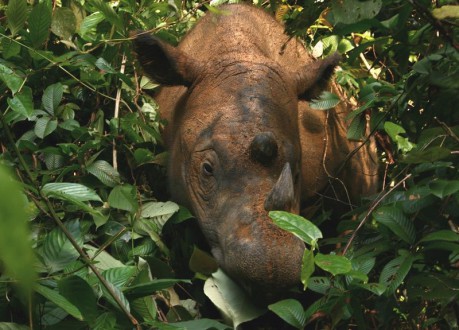
I have been involved for nearly four decades in endangered wildlife work in Malaysia and Indonesia, most closely with the Asian Two-horned Rhinoceros, Dicerorhinus sumatrensis, commonly known as Sumatran rhinoceros. Early on, I believed that a combination of a protected areas and a global captive breeding program would save the species. Now that the species is on the edge of extinction, it is clear that neither method has worked, and that the only options are to give up entirely, or engage in a new approach, where the sole and uninhibited goal is to produce as many individual Dicerorhinus rhinos, as soon as possible.
A millennium ago, this smallest member of an ancient (c. 20 million years) line of rhinoceros occurred in many regions of Southeast Asia, eastwards from what is now Bangladesh and southwards from Sichuan. Due to a variety of causes, notably many centuries of use of the horns of hunted wild rhinos in traditional Chinese medicine, the species’ distribution and numbers declined drastically, and by 1933, this rhino became the most endangered species in Malaysia.
One of the arguments provided in 1930s for establishment of King George V National Park (now Taman Negara and still the largest protected area in Malaysia) was the need for a large forest sanctuary for the tiny number of Sumatran rhinos that occurred there, and the argument was used again in the 1980s for establishment of Endau-Rompin Parks in the south part of Peninsular Malaysia. Similarly, Tabin Wildlife Reserve was established in Sabah (northern Borneo, and a part of Malaysia) in 1984 because the last few known breeding individuals occurred in that area.

The obvious online sources of information on Dicerorhinus sumatrensis tend to have us believe that it is still simply threatened by poaching and habitat loss, and that it will be saved by continued efforts to reduce poaching. A more detailed look through the literature on Dicerorhinus rhinos over the past century, available at the excellent Rhino Resource Centre, reveals that by 1930s, knowledge already existed that this genus was critically endangered throughout its range. Even then, the scattered, tiny remnant wild populations were likely threatened as much by insufficient births as by poaching.
When a population of animals declines to very low numbers and is scattered, there comes a point where, even in the absence of human hunting, death rate inevitably surpasses birth rate, and it is just a matter of time before the species goes extinct. This phenomenon is known as the Allee effect, first outlined in the 1930s, and summarised by professional biologists as “positive correlation between population density and individual fitness.” Usually, several factors are involved in the decline, including inbreeding depression (all individuals are related when few exist in one area for two or three generations), difficulty finding a receptive, fertile mate (especially for non-herding species like Dicerorhinus), randomly skewed sex ratio, and female reproductive tract pathology that develops as a result of chronic absence of pregnancies.
There is no way to reliably estimate numbers of wild rhinos in rainforest. This is because they are solitary with little sexual dimorphism, and almost never seen. Estimation of Dicerorhinus numbers between 1970s and 2005 was done by locating rhino footprints and measuring their widths, which are barely distinguishable as individuals among adult rhinos. Camera traps can help improve accuracy, but they cannot solve the underlying issue of a miniscule population. Tens of thousands of camera trap-days for Danum Valley and Tabin Wildlife Reserve in Sabah between 2008 and 2015 revealed the presence of three females and no male – of those, two have been captured and one is presumed dead. The fact that people cannot find rhinos after months or years of searching is due to there being no rhinos or, where footprints are found, just one or two. This is why recent ideas to survey the species by faecal DNA and blood from forest leeches will take vast effort yet fail in their objective.
Rhino numbers were repeatedly over-estimated in Malaysia from the 1960s right up to 2014. Hamid et al. (2014) showed that published Dicerorhinus numbers after 1970s for Malaysia have been inflated guesses, maintained with good intentions by hopeful government departments and NGOs, with the implication that the same syndrome might persist in Indonesia.
In April 2015, the Sabah State Minister for Tourism, Culture and Environment announced that the Malaysian federated state of Sabah is unlikely to support any wild rhinos. The Minister’s unstated point was that only three Dicerorhinus remain alive in Malaysia, all in Sabah, where they are cared for in closely managed facilities in Tabin Wildlife Reserve, as a source of gametes to produce embryos. A male (named Tam, captured 2008) is healthy but beyond reproductive prime, and his sperm production is declining. One female (named Puntung, captured 2011, Tabin’s last wild rhino) has severe cyst growth throughout the uterus and, although she produces ova, there is no prospect for a successful pregnancy. The other female (named Iman, captured 2014, the last wild rhino in Danum Valley) is in even worse condition, with massive tumours (fibroids). She is currently under treatment to halt her oestrus cycling in an attempt to cause the tumours to regress.
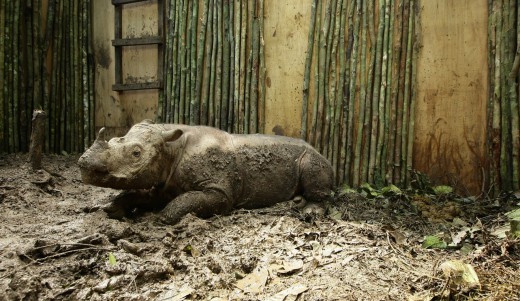
Havmøller et al. (2015) stated that “it is safe to consider the Sumatran rhinoceros extinct in the wild in Malaysia.” As one of the co-authors of this paper, I can say that one of the points in making this statement was to show that all the methods tried to date to save the species have not worked, and that we need to seek ways to make best use of the last three Dicerorhinus in Malaysia. Regrettably, on 22 September, IUCN released this statement: “It takes the rhino down to a single country,” said Simon Stuart, chair of the IUCN’s species survival commission. “With the ongoing poaching crisis, escalating population decline and destruction of suitable habitat, extinction of the Sumatran rhino in the near future is becoming increasingly likely.”
Captive breeding has been tried before. In 1984 in Singapore, IUCN brokered an agreement—among the Governments of Indonesia, Peninsular Malaysia and Sabah and a consortium of US and British zoos—to form a globally managed captive population of Sumatran rhinos, with the rhinos to come from then-forested land outside protected areas. Between 1984 and 1994, 40 “doomed” Sumatran rhinos—those for which future viability was considered unsatisfactory—were captured from Peninsular Malaysia, Sabah and Sumatra. Despite incredibly dedicated and competent people supporting this effort, 45 captive Dicerorhinus produced only four offspring in 30 years.
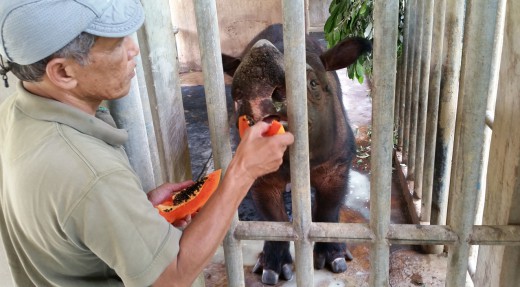
The apparent failure of that program has exacerbated skepticism over the idea of capturing and maintaining Sumatran rhinos in fenced facilities. However, leaving the last few wild Dicerorhinus in the forest, reducing poaching risk as far as possible and hoping for the best, ignores some crucial points. Firstly, there are now far fewer Sumatran rhinos alive than in 1984, and the most likely fate of all wild survivors is death without breeding, whether at the hands of poachers or through age or reproductive pathology. More than half of all female Dicerorhinus have significant reproductive tract pathology which inhibits or prevents pregnancies, a fact largely ignored outside Malaysia.
Secondly, advanced reproductive technology (ART) is far more sophisticated now than in 1984 and would be improving rapidly if there were more efforts like those undertaken by the in-vitro dog researchers. The need to prioritise production of embryos (over anti-poaching, awareness, and counting rhinos) is not just greater now, but absolutely essential. It is not as if the idea of ART is new. China produced the first baby giant panda from artificial insemination in 1963. Public literature says that 5 million living humans are the result of inserting an in vitro-produced embryo into a surrogate mother, with about half a million cattle and tens of thousands of horses produced annually in the same way. One wonders why have such techniques not been attempted repeatedly and perfected for Sumatran rhino?
While the establishment of protected areas and prevention of poaching have been considered appropriate for the great majority of wild species, they have not been adequate for the rhinoceros in Malaysia. The sparse isolated populations have decreased breeding (the Allee effect), and the suitability of the habitat where the last few rhinos existed was uncertain.
Total global numbers of Dicerorhinus have now dwindled to fewer than 100, scattered through five separate areas (three in Sumatra, two in Borneo), all likely inbred, yet many biologists resist the obvious conclusion that the species can survive only through massive efforts to push birth rate above death rate, in short, by producing many babies, as soon as possible.
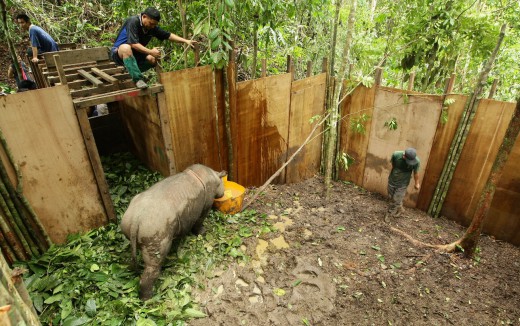
Detractors to this idea commonly offer several reasons for not trying to produce wild mammal babies in captive conditions. Two revolve around ethics (“playing God”) and the fact that all species eventually go extinct, both of which I take to be matters of opinion by armchair philosophers, and resistant to rational argument. Another is that funds could be better spent on other things, a largely spurious argument that is also used in relation to house buying, handbags, expensive Christmas gifts, and many other things.
A more reasonable objection is: what do you do with all the babies in the event of success? It is true that for many mammal species, the need for learning from the mother, notably in seeking and capturing food, is so profound that captive-born babies may well experience too many problems to contemplate. But a genus that has been around for 20 million years, feeding on a wide variety of woody leaves in a variety of forest types, temperate to tropical (i.e., Dicerorhinus), should be able to adapt as long as thoughtful and disciplined human keepers adhere to standard operating procedures. Some pedants, unwilling to give in, say that there will not be any rainforest around fifty years from now. Apart from being overly pessimistic, why not let your hair down and imagine Dicerorhinus as woody weed removers in oil palm plantations.
There also exists a misguided argument that public knowledge of very low numbers or the extinction of Dicerorhinus from a protected area will allow governments to release those areas for logging or deforestation. It is foolhardy to argue for protection of a particular forest area based on saving a single species that is likely to go extinct from the area. Tropical rainforest protected areas are essential for tens of thousands of species, not just for large mammals – which in any case tend to do better in damaged lowland forests and forest edge.
A much more reasoned and contemplative concern against applying ART to prevent the extinction of endangered species has come from one of its foremost pioneers, David Wildt. It seems that his carefully-reasoned thinking has become overly-simplified into “use ART as a very last resort”. However, for some species, including Dicerorhinus, we have reached the “last resort” stage. In addition, debate and decision-making on what to do with mammal species that are about to go extinct has been captured not by veterinarians and reproductive biologists, but largely by “conservation biologists” (who know of the shifting baseline syndrome but seem unaware that they are caught out by it, and who are seduced by the promise of new survey technology and statistical methods rather than rational thinking), sometimes together with foresters (because Asian wildlife tends to live in forests, and so authority over wildlife may tend to come, since colonial times, under the forest bureaucracy).
And those factors are the crux of the problem. This is what we now need to think: “while some of the last few wild individuals are still producing gametes, make the policy decision to concentrate them into custom-built facilities, the whole program managed by experienced veterinarians, and start producing embryos by whatever means available.
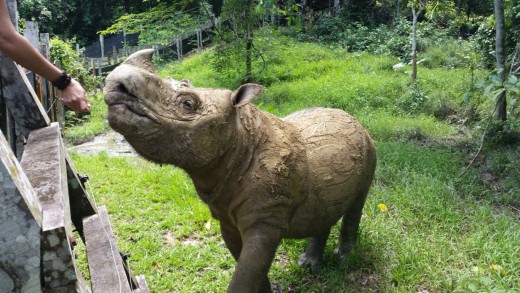
For that, advanced reproductive technology is necessary, prioritizing artificial insemination for fertile individuals and in-vitro fertilization for the sub-fertile. Embryos are only of use if fertile surrogate mothers are available. Although there are hardly any of those left (much closer to zero than 100), three are already cared for in the excellent facilities at Way Kambas, Sumatra. Two have never bred. Whether or not any additional females can be secured depends on governmental policy and on the logistics of whether any particular rhino can be safely captured and relocated from a remote forest.
Malaysian government policy is to not give up on Dicerorhinus but to make best use of the three remaining individuals in Sabah as sources of gametes to produce embryos in vitro. Leibniz Institute for Zoo and Wildlife Research (Berlin) and Avantea laboratories (Italy) made the first in vitro attempts in 2014, unsuccessful due to several factors, not least the long travel time involved in bringing unfrozen gametes from Sabah to Europe. In 2015, several local research institutions came into the picture, along with an Indonesian in vitro specialist, and all are ready to proceed. Without the trust and major funding support accorded by (Malaysian) Sime Darby Foundation since 2009, the species would be extinct in Malaysia by now. My regret is that we have no support, either in policy or funding, from any of the global or rhino conservation NGOs or from IUCN or, so far, from Indonesia. Rather, there is deflection of the critical issues, commonly towards nationalistic thinking or the threat from oil palm development, the latter being irrelevant in the demise and current status of Dicerorhinus.
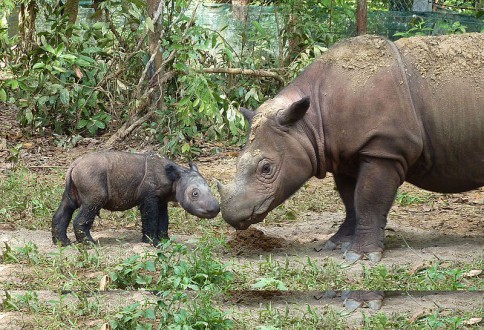
Just as in the 1980s, wrong decisions, no decisions and delayed decisions continue to facilitate this species’ decline towards extinction. Why does this happen? Essentially, the answer lies in current fashions in the nature conservation world, which are in turn generated by cognitive biases. If you only look at one link in this article, look at this one and understand cognitive biases.
Is advanced reproductive technology the answer to many species on the edge of extinction? Definitely not. Even amongst large mammals, those which number above 1,000 individuals in total, those that live in groups, those that are easily seen, and those that can breed yearly will not need it. But the sooner we start with Dicerorhinus, Javan rhino and saola, the better. Come on, wildlife conservationists, get rid of your cognitive biases.
Citations
Rasmus Gren Havmøller, Junaidi Payne, Widodo Ramono, Susie Ellis, K. Yoganand, Barney Long, Eric Dinerstein, A. Christy Williams, Rudi H. Putra, Jamal Gawi, Bibhab Kumar Talukdar and Neil Burgess. Will current conservation responses save the Critically Endangered Sumatran rhinoceros Dicerorhinus sumatrensis?. Oryx, available on CJO2015. doi:10.1017/S0030605315000472.
